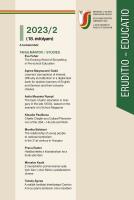The relationship of young people to national symbolism in the 21st century in Hungary
The relationship of young people to national symbolism in the 21st century in Hungary
Author(s): Monika BalatoniSubject(s): Anthropology, Social Sciences, Culture and social structure
Published by: Pedagogická fakulta Univerzity J. Selyeho
Keywords: national memory; national identity; civic values; enculturation
Summary/Abstract: The civic values of a 21st century man, the acquisition of the traditions and symbols of his own national culture are changing. The sustainability of the process of national enculturation and the significant impact exerted by the media pose serious challenges for the leaders of states, the creators of school systems and methodologies, as wellas the representatives of arts. One of the most effective and dominant actors in enculturation can be the state, which maintains the institutions shaping their methodology, gives direction for and often specifies the content through funding, and provides public law definitions of the symbols that can be decisive for citizens in this process of enculturation. The younger generation’s openness for cultural traditions and their historical memory are of particular interest here. The concept of enculturation was introduced by M. J. Herskovits (1962). Enculturation is a most comprehensive learning process. This means the acquisition of basic skills, which are indispensable for all human beings. These skills are gained through the help provided by the institutions and forms of activity established by the society and through education. To continue this idea, these skills are indispensable in the Hungarian society, where they are gained through the help of the institutions and forms of activity established by the society, such as language, religion, technology, art, sport, and through education. Education is the most important means of reproducing the culture of a society in the individual and passing it on to each generation. My study was designed to briefly represent the results of a micro-survey, which paved the way for a collection of nation-wide data. I collected the presented research data during a small sample survey to prepare a questionnaire (pending) to gain a deeper understanding of the national memory of university students. The form of the study is a research paper. It reflects a state at a given point of the research, commenting on the relevant findings of literature, and raising new dilemmas in a changing youth scenario, which I would like to analyse in their deeper patterns later.
Journal: Eruditio - Educatio
- Issue Year: 18/2023
- Issue No: 2.
- Page Range: 072-080
- Page Count: 9
- Language: English

